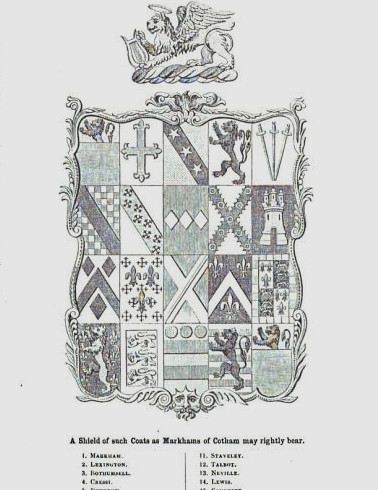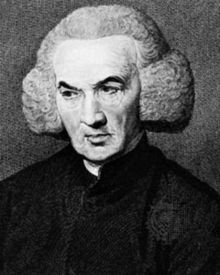George Markham Tweddell and the Markham Family
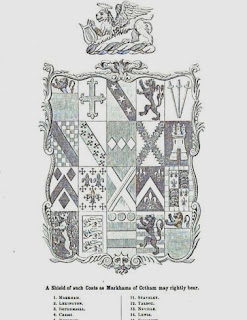 |
| The Markham Coat of Arms |
This post is an attempt to bring together what we know of George Markham Tweddell’s (GMT) relation Paul Markham Tweddell, who until is death in 2010, spent many years researching his ancestors, and in association with me, making much of that research available on the internet. His full genealogical book, unfinished at his demise, is currently being prepared for publication by Paul’s wife, Sandra but may take a while as a lot of Paul’s later research still needs to be integrated into the text. Paul’s book covers the full Tweddell family history.
to his father’s family – the Markhams. I pull together material from
From Paul Tweddell’s website http://www.tweddellhistory.co.uk/
“George Tweddell (the name by which he was baptised) was born on 20th March 1823 and claimed he was the son of a Royal Navy Lieutenant, George Markham, who had been born in 1797 in the Rectory, Stokesley. His father, another George Markham (1763-1822), was the Rector of Stokesley, whilst also holding the post of Dean of York, and his grandfather was Archbishop Markham (1719-1807), famed for saving the walls of York from demolition in the first decade of the nineteenth century with the help of the author Walter Scott.“
The Plantagenets and Cromwell
On one of our walks through Stokesley, taking me along his ‘Tweddell Trail’, Paul mentioned that through the
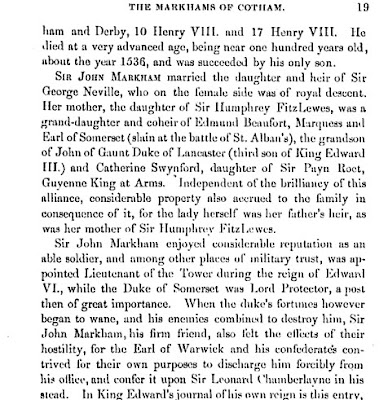 |
| Sir Clements Markham’s family history of 1913 |
Markham line, GMT was related both to Kings (the Plantagenet line) AND Oliver Cromwell! (GMT mentions the relation to Oliver Cromwell in Bards and Authors of Cleveland and South Durham and in the page pictured here from Sir Clement’s Markham’s Family History of 1913, (link to this book on line below) it says “Sir John Markham was descended through John of Gaunt Duke of Lancaster (third son of King Edward 111)“. Yet, although GMT was estranged from his father’s family, brought up by his mother and living in relative poverty most of his life with no University education, he emerged as an impressive and energetic figure showing no lack of learning, wisdom and enterprise and leaving a large body of work – books, tractates, newspapers and poetry behind him. Long before modern communication systems and the internet, his regional, national and international network – often through the masonic craft, is still being unraveled and marveled at! Looking through Sir Clements book, it’s noticeable that quite a few of the Markhams were also bards and it seems to me that GMT’s ‘lyre’ as he would refer to his muse, fits neatly in with this.
 GMT dedicated his inherited genes in the People’s cause, firmly behind the Chartist movement, anti-slavery, Cleveland News and Stokesley Reporter, established when he was only 19 and written about on this blog. Samuel Johnson wrote in 1775 “I never think I have hit hard unless it rebounds“, Paul and I picked up a pamphlet in the Yorkshire store in Stokesley called the The Stokesley Trail in 2008 and found an entry about GMT on page 29 which amused us a little – in regard to Rose Cottage (the Town House with its ‘fine sepertine bow), it reads –
GMT dedicated his inherited genes in the People’s cause, firmly behind the Chartist movement, anti-slavery, Cleveland News and Stokesley Reporter, established when he was only 19 and written about on this blog. Samuel Johnson wrote in 1775 “I never think I have hit hard unless it rebounds“, Paul and I picked up a pamphlet in the Yorkshire store in Stokesley called the The Stokesley Trail in 2008 and found an entry about GMT on page 29 which amused us a little – in regard to Rose Cottage (the Town House with its ‘fine sepertine bow), it reads –
anti Corn laws and much more and writing a People’s history of Cleveland. His wide body of poetry reveals a man who cared about people and sound values regardless of their social or financial position and envisioned a better world through wider education, culture and progressive political change. Not everyone liked him – you have to look at reaction to his radical paper the
“George Tweddell lived here in the 1800’s, a man of many interests, poet, historian, stirrer-up of controversy, publisher etc.” (My italics). GMT died in 1903 and his reputation still ‘rebounds’ today! Paul thought ‘stirrer up of controversy’ a telling expression and among other things, might be accounted for by his support of the People’s Charter and other political concerns.
Lieutenant, George Markham?
Paul Tweddell tells us –
“Lt Markham had lived an adventurous life in the Royal Navy, had been mentioned in dispatches during the late Napoleonic campaign on the Mediterranean coast of France and was wounded in the Siege of Algiers in 1816. Obviously, one must imagine that his dalliance with Elizabeth Tweddell (1800-1841) while on leave in Stokesley during summer 1822 resulted in George Tweddell’s birth the next year and must have been a typical event in the pre-Victorian period. So too was the way the child was welcomed by this mother’s yeoman family without social problems; George would be perceived as an extra worker in the family’s various enterprises and brought the added advantages of ‘noble blood’ to add it to the Tweddell line. Members of the following generations used to say George had ‘aristocratic hands’, by which they meant broad, long and powerful hands and fingers with slim wrists. But these same people found it difficult to accept the circumstances of George’s birth, living as they did a generation later during Victorian and Edwardian times when the hypocrisy prevalent during the period (what they called ‘respectability’) had taken its grip on changed social norms. The family made up a story to rationalise George’s illegitimacy presumably so they could continue to discuss George’s literary exploits and the glorious history of their Markham ancestors (which stretched back through John of Gaunt to the pre-Norman thane, Claron of West Markham) whilst preserving their own ‘decorum’.”
“Lieutenant George is the subject of a brief chapter (§19) in Sir Clements Markham’s family history of 1913, Markham Memorials, stating that, during the time of his relation with Elizabeth Tweddell (the author makes no mention of it, unsurprisingly), he was suffering from a head injury the result of a fight following a dispute during a gambling game at sea. Perhaps Elizabeth found him an attractive partner – prestigious and courageous but also in need of her feminine reassurance. Although he returned to sea, Lt Markham never recovered from the injury and died in 1834 tended by his second sister, Henrietta Montgomery, at her home, Nunton House near Salisbury where her husband was vicar. Documentary evidence of Lt George’s death was available in George Tweddell’s time in Foster’s Pedigrees of the County Families of Yorkshire (1874), but one must assume he could not have found it, as he leaves a gap for his father’s date of death in his notes, presumably hoping to fill it in when he found it.”
For further research see –
Sir Clements Markham’s family history of 1913 – preview here –
http://books.google.co.uk/books?id=B9s1AAAAMAAJ&printsec=frontcover#v=onepage&q&f=false
GMT Makes Contact with Frederica Havisides née Markham.
Paul Tweddell tells us that “Whilst still in Bury (as Master of the Bury Ragged or Industrial School) c 1855 – 60), George made contact with a member of his father’s family, Frederica Haviside (1798-1863), a younger sister of his father, who lived in the (then rural) Rectory Manor, Walthamstow. In 1859 Frederica sent him two paintings of her house with a dedication recording her gift to him, framed in gilt. By the time Frederica, now widowed, wrote her last will George and Elizabeth were living in Middlesbrough, and when she died in 1863 her will showed she had bequeathed an annuity of £100 per annum (perhaps in today’s money something like £5 or 6000 (roughly £100 a week) for the term of their lives. On the early installments of the bequest the couple set up a business ‘Tweddell and Sons’ as newsagent and printers at 87 Linthorpe Road, Middlesbrough. In gratitude George penned a sonnet to celebrate Frederica’s life. Frederica kept up a correspondence with her nephew before her death.”
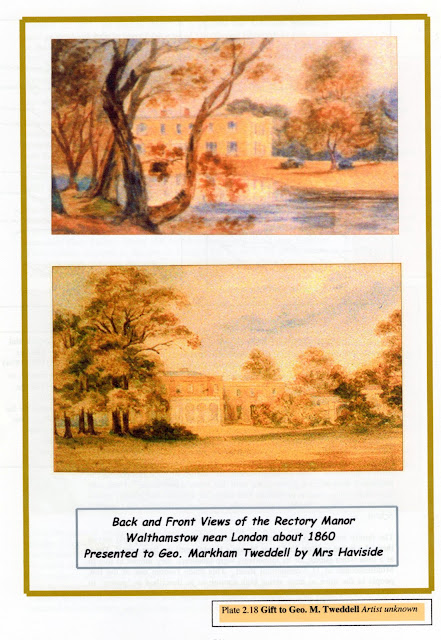 |
| Rectory Manor, Walthamstow 1860 From Paul Tweddell’s book on the Tweddell’s |
In another bio Paul Tweddell tells us – “Shortly after arriving in Bury, Tweddell took the opportunity to add Markham as his middle name; the first recorded mention being written in his hand: ‘Bury, December 15th, 1855’,[xix] (and from then on often appears abbreviated to ‘GMT’). Despite publicising the change in the national Freemason newspaper and what it signified, the Markham family seems to have accepted it. The reason why was to appear shortly after his return northward .
From North of England Tractates No. 7
Cleveland Sonnets (1870)
“Sonnet 10 was addressed to my Father’s sister, Frederica, daughter of the late Dean Markham. She was born at Stokesley Rectory, and ever cherished a strong love for Cleveland. An angel on her sojourn here, she is now one in heaven.George Markham Tweddell Stokesley April 23rd 1870″
–
Whilst in the Cape he journeyed to Algoa Bay to supervise the landing of the organised British immigrants
(whom we refer to as “The Settlers” today). He immediately saw that a sea-port would be necessary if the new settlements in the Eastern Cape were to be viable. On 6 June 1820 he named the site of the landings, and the temporary “tent city”, Port Elizabeth; and arranged land for those who could invest.
In August 1820 he selected the site of today’s Donkin Reserve, as the position to build a memorial to his late wife. In the early 1800s pyramids were a not an uncommon memorial in both India and England, and the one he commissioned was based on that of an ancient Roman, Caius Cestius.”
Read more From http://www.momentos.co.za/donstory.htm
Interestingly Fearon Fallows “was sent to Cape Town by the Royal Astronomical Society to start the Cape Observatory. This was to be the first Astronomical Observatory in the Southern Hemisphere (As well as the first Scientific establishment in the Southern Hemisphere). He was chosen for the post at the Cape because of his skills in mathematics and astronomy. In Cape Town he was well received by the Acting Governor, Sir Rufane Donkin, and the Colonial Secretary,Colonel Bird. Fallows had to set up a temporary observatory to provide time signals and to set make a catalogue of Southern stars. Sir Rufane Donkin had some wooden houses for British settlers in Port Elizabeth. He kindly provided Fallows with a wooden house, which was to serve as a temporary observatory. Fallows was a Freemason at the Good Hope Lodge.” Abridged from http://assa.saao.ac.za/html/his-astr-fallows_f.html
William Markham – Archbishop of York 1719-1807
William Markham was GMT’s great grandfather, famed for saving the walls of York from demolition in the first decade of the nineteenth century with the help of the author Walter Scott.
I won’t comment greatly on William Markham as I would need to study him more closely, but i think this would be essential in any full study of the Archbishop’s great grandson – George Markham Tweddell for the parallels and differences. The Archbishop was the son of major William Markham –
“Son of Major William and Elizabeth. He was born at Kinsale in co.Cork on 9 April 1719 and attended Westminster School and Christ Church, Oxford. After ordination he took up teaching and became Head Master of his old school in 1753. Later he held the post of chaplain to George II, and served as prebendary of Durham Cathedral, Dean of Rochester, Dean of Christ Church, Bishop of Chester and lastly Archbishop of York and Lord High Almoner. On 16 June 1759 in London he married Sarah, daughter of John Goddard a merchant at Rotterdam. Sarah was born in Holland 14 February 1739 and died 26 January 1814.” http://www.westminster-abbey.org/our-history/people/markham-family
In relation to Archbishop Markham, I refer you to Sir Robert Clement’s “A Memoir of Archbishop William Markham” which can be read on line or downloaded as a PDF on Open Library here http://archive.org/details/memoirofarchbish00markiala
It explains the family’s loss of inheritance and the struggle to recover from it that affected the early life of the Archbishop. He and his father were Whigs and supporters of the ‘Glorious Revolution‘ and although the principles of that were strong in the family, Archbishop Markham, the book explains, was a critic of Richard Price and the American Revolution on the grounds that the Glorious revolution was founded on the supremacy of law, while the American Revolution as deemed to be lawless. A full account of this and the reasons given are in the above book p 46-49.
I feel sure that Richard Price would have been someone GMT would have supported with his connections with the Unitarian Church and ideas on egalitarianism and although i haven’t found anything yet, there may well be some reference to Price in Tweddell’s work somewhere –
“Richard Price (23 February 1723 – 19 April 1791) was a Welsh moral philosopher and preacher in the
tradition of English Dissenters, and a political pamphleteer, active in radical, republican, and liberal causes such as the American Revolution. He fostered connections between a large number of people, including writers of theConstitution of the United States. He spent most of his adult life as minister of Newington Green Unitarian Church, where possibly the congregant he most influenced was early feminist Mary Wollstonecraft, who extended his ideas on the egalitarianism inherent in the spirit of the French Revolution to encompass women’s rights as well. In addition to his work as a moral and political philosopher, he also wrote on issues of statistics and finance, and was inducted into the Royal Society for these contributions.”
http://en.wikipedia.org/wiki/Richard_Price
Archbishop Markham was a poet, often writing in Latin (including a Latin version of Shakespeare’s Seven Ages of Man) and a close friend and supporter of Edmund Burke (as described in the book). Burke was a supporter of the American revolutionaries but not the French which led him to move to the right of the Whig party.
George Markham Dean of York – Rector of Stokesley 1763 – 1822
George Markham was GMT’s grandfather, living at the Rectory in Stokesley until not long before GMT’sAlice Barrigan in her essay
 |
| George Markham – Dean of York |
birth when he died in 1822. George was, according to local historian –
Radicalism in Stokesley in the 1820s – herehttp://northyorkshirehistory.blogspot.co.uk/2012/11/radicalism-in-stokesley-in-1820s.html
Robert Armstrong – owner of a Zetetic bookshop in Stokesley, publishing the likes of Thomas Paine and involved in a Stokesley ‘paper war‘, similar to the one GMT would be involved with 20 years later in regard to his own radical newspaper – is shown by Alice to have admired the Dean of York – George Markham as follows –
“The position of the Stokesley Deists was rather more nuanced and the rift between Church and chapel was growing. According to Robert Armstrong‘s third letter of 3 November 1822, he himself
“frequently derived both pleasure and improvement from the Sermons of our late Rector, the deservedly lamented Dean of York ; because I considered his Sermons true Deistical and moral compositions”.
“I do sometimes go to Church”,”
Below is from Sir Robert Clement’s Markham’s family history of 1913 (Click link to view this book)
